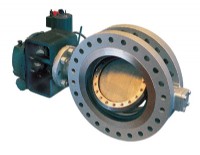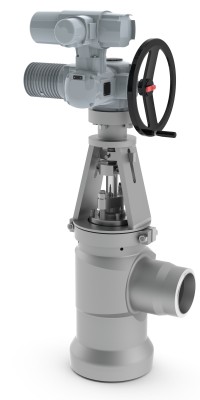Valve 2025: A Look Ahead!

Director Rob Bartlett presents David Dunbar with a BVAA umbrella at Valve World

Anderson Greenwood series 400 modulating pilot operated pressure relief valve

Vanessa series 30,000 triple offset rotary process valve

Sempell type 140 boiler startup control valve
RB: ‘David, what inspired you to write this paper?’
DD: ‘Well Rob, when I tell people I’m in the valve business, they tend to assume because it is a mature industry that it is not dynamic and I wanted to dispel the notion that it is sleepy and dull.’
RB: ‘I know that feeling! How do you believe they should react?’
DD: ‘I think they should see us as the dynamic, forward-thinking industry we are! Our products are involved somewhere in almost every aspect of daily life and the industry plays a vital role in global advancement.’
RB: ‘How would it be if we were not around?’
DD: ‘Frankly, without us, the world wouldn’t have its most important infrastructures, or access to our most important resources. Our innovations may not evolve at the rate of computer processing, but they have contributed to the globalization of businessand to the world’s ability to access and manage everything... from gold to beer!’
RB: ‘Tell me more about Tyco Flow Control.’
DD: ‘Today, we are the largest valve company in the world. But as the industry remains highly fragmented, we have over 5,000 competitors! However, if you look at our customers, many are household names, recognizable on just about every continent.’
RB: ‘How are Tyco managing such a diverse customer base?’
DD: ‘We are a global leader in process isolation, pressure management valves, nuclear safety valves and slurry process valves. Our HQ is in Switzerland, but we have over 8,000 employees globally. Recently, we reorganized Valves & Controls to align with the vertical industries our customers operate in, rather than around geography. The goal is to build a new, more global organization that does the business our customers want us to. Our key vertical business units are now Process, Oil & Gas, and Power & Mining. We have three product groups, Pressure Management, Triple Off-Set Valves and Actuation & Controls. This allows us to better partner with our customers to offer enhanced end-to-end solutions.’
RB: ‘How do you feel this connects with “Valve 2025”?’
DD: ‘Tyco is a good illustration both of what is happening now in our industry, and what we can expect in the next 15 years. Let’s look at what is shaping our industry now. The globalization of customers in the past decade has been rapid in all industries. They are now expecting consistent levels of service and support around the world. At Tyco, the companies that make up valves and controls are coming together to provide this consistency as a single, global entity.
RB: ‘I imagine this impacts on service too?’
DD: ‘Global customers require local services… globally! It’s necessary as they supplement customers’ lack of internal skilled resource with external providers. We operate in 45 countries in 300 locations and have been partnering and supporting our global customers wherever and whenever they need us. Customers are increasingly linking maintenance of their installed equipment to quality improvement strategies and the use of maintenance as a competitive strategy. Moving from the idea that equipment components are liabilities that break down and cause problems to considering them as assets to be managed competitively is new thinking.
RB: ‘And this connects to the “2025” vision also?’
DD: ‘Yes. For example, since the early 1900s pressure relief technology has continued to evolve providing for improved safety, great application flexibility and range, lower cost of ownership and improved operating parameters for greater system throughput. However, the evolution of PRV technology has been gradual and acceptance of new technology relatively slow when compared to technology advances in other markets. Over an 85 year period PRVs have evolved from basic, weight loaded, moment arm designs, to full nozzle API 526 spring valves, balanced bellows valves, to early pilot operated valves and into today’s non-flow, modulating pilot operated valves.’
RB: ‘Do you find new designs are embraced immediately by customers?’
DD: ‘Sometimes it’s a slow process. We estimate that as many as 40% of applications in the process industry would benefit from the features and benefits of our latest PRV technology; however it has about 18-20% market share today. And this technology continues to evolve. PRVs will continue to be fully self-actuated, but also integrated into
safety control systems for monitoring for a relieving cycle, seat leakage and other maintenance needs. The valves will also be integrated into the safety control system such that the valves will be able to be actuated by electronic or hydraulic signal as part of the overall safety system. In addition, manufacturers will continue to adapt materials that allow for lighter, longer performing and more economical use of the valves. Additionally, due to the safety function of these valves, they require that a complete history of the sizing criteria, maintenance records and other information be maintained indefinitely. In the near future this information will be “stored” and/or “tied” to the valve
through electronic tagging or identification.’
RB: ‘Do you have other examples?’
DD: ‘Take the evolution of the triple offset valve. Unlike some consumer products, like cell phones that progressed from the giant ‘bricks’ of the 1980s to the smart phones of today, the changes aren’t highly visible. Nevertheless, these are significant advancements for the customer. In the late 1960s the first TOVs were introduced and were seen by end users and EPCs as a simple extension of the already existing range of High Performance Butterfly Valves. By the end of the 1980s important changes were introduced. One TOV manufacturer, Vanessa, introduced a new concept for process isolation applications, namely “Metal Seated Zero Leakage”.’
RB: ‘How was this greeted by customers?’
DD: ‘It presented an interesting problem, because no specifications existed that called for the TOV’s capabilities. Until then, all standards for metal seated valves allowed for leakage when tested at ambient temperature. This of course made it difficult for end users and EPCs to specify the product, but oil and gas and process industries began to use them nonetheless. Usage expanded in 2000, when Shell became the first end user to accept TOVs as a true process valve. This created a new category in process that was obviously different than conventional double offset HPBVs, and from balls and gates.’
RB: ‘So valve development was ahead of the game?’
DD: ‘Indeed. And customers are valuing TOVs beyond their zero leakage performance. They have proven to be an excellent replacement for ball valves in certain applications. They function effectively in extreme temperatures and pressures. They weigh less, save space, and they cost less to support, transport and maintain, which means lower costs overall for customers.’
RB: ‘Any more like that in the pipeline?’
DD: ‘We expect the temperature and pressure that power plants are operating under in 2025 to be essentially double that of 1975. We have to produce valves that can withstand those conditions. Tyco Sempell has been hard at work creating products that incorporate critical design features and materials to do just that. These are the kind of
products that customers will need in the extreme conditions they are dealing with.’
RB: ‘Does standardisation have a role to play in this?’
DD: ‘Codes and standards have a long and honourable history and they too have transitioned to meet the globalized demands of end-users and manufacturers. Looking ahead, we know markets are changing quickly and emerging markets will bring new demands. The advancement of materials, the development of some processes and related technology is outpacing standards development, which may limit the application of harmonized standards. For our industry to benefit from such standards we must see improved adoption rates. For example, as a valve manufacturer we are still being required by many of our end-users to meet local codes and standards in addition to the newer harmonized ones.
RB: ‘So how would you sum up?’
DD: ‘The valve industry has a lot to be proud of. At Tyco, we serve local communities around the globe. We partner with customers to help improve their operation efficiency, minimize risk and protect what’s most vital: people, assets and the environment. When we’re protecting the things most vital to our society, we can’t help but feel proud of what we do. Some serious challenges lie ahead but our industry has survived and thrived under such conditions for more than 4000 years. I am confident that we’ll prosper in the next 15!
Published: 31st March 2011
Rachel Wormald, Managing Director at YPS Valves Ltd and Elizabeth Waterman, ...
Are you looking for industry-leading, brand independent valve and actuator ...
As can be seen from the photograph, clearly the resident birds at Bartlett ...
Howco Group has unveiled its latest £1million investment, with the ...
In 2024, Allvalves is poised for an exciting year of growth and expansion, ...
GMM Pfaudler Engineered Plastics & Gaskets are delighted to bring the ...
In the ever-evolving valve industry, GMM Pfaudler stands out for its ...
SAMSON Controls Ltd – part of the SAMSON group - a renowned leader in ...










